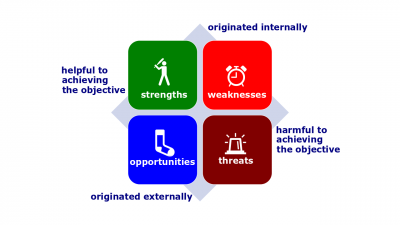Difference between revisions of "SWOT analysis"
| Line 1: | Line 1: | ||
| − | [[File:Swot.png|400px|thumb|right|[[SWOT framework]]]][[SWOT analysis]] (alternatively known as | + | [[File:Swot.png|400px|thumb|right|[[SWOT framework]]]][[SWOT analysis]] (alternatively known as [[SWOT framework]]; hereinafter, the ''Framework'') is a tool that maps analyses of the [[enterprise environment]]. SWOT is an acronym for [[strength|'''s'''trength]]s, [[weakness|'''w'''eakness]]es, [[opportunity|'''o'''pportuniti]]es, and [[threat|'''t'''hreat]]s. |
Revision as of 02:20, 12 June 2020
SWOT analysis (alternatively known as SWOT framework; hereinafter, the Framework) is a tool that maps analyses of the enterprise environment. SWOT is an acronym for strengths, weaknesses, opportunities, and threats.
Definition
According to Management by Robbins and Coulter (14th edition),
- SWOT analysis. An analysis of the organization's strengths, weaknesses, opportunities, and threats.
Components
- Strength. Any activity the organization does well or its unique resource.
- Weakness. An activity the organization does not do well or a resource it needs but does not possess.
- Opportunity. A positive trend in the enterprise environment.
- Threat. A negative trend in the enterprise environment.
